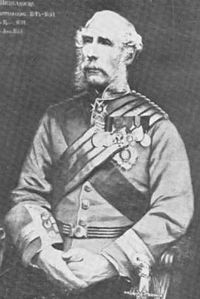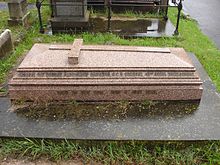- Duncan Alexander Cameron
-
Sir Duncan Alexander Cameron 
General Sir Duncan Alexander Cameron, GCBBorn 20 May 1808
Thorncliffe, Hampshire, EnglandDied 8 June 1888 (aged 80)
Blackheath, Kent, EnglandAllegiance  United Kingdom
United KingdomService/branch  British Army
British ArmyYears of service 1825-1875 Rank General Commands held 42nd Highland Regiment
Highland Brigade (Scottish)
Royal Military Academy SandhurstBattles/wars Battle of Alma
Second Taranaki WarAwards Companion of the Order of the Bath
Order of St. AndrewRelations Lieut.-Gen. Sir John Cameron, KCB (1773-1844) (father)
Lieut.-Gen. John Cameron, RE, CB, FRS (1817-1878), Director-General of the Ordnance Survey (brother)General Sir Duncan Alexander Cameron GCB[1] (20 May 1808 – 8 June 1888) was a British Army officer who fought in the Crimean War (1853–1856), commanded troops during part of the New Zealand Land Wars and was Governor of the Royal Military College Sandhurst from 1868 to 1875.
Contents
Career
Cameron was a 42nd Regiment of Foot officer (lieutenant 1826,[2] captain 1833,[3] major 1839,[4] and colonel 1854[5]).
He was awarded Officer of the Legion of Honour,[6] received the order of the Medjidie (1858),[7] and was commander of H.M. Forces in Scotland (1860)
New Zealand deployment[8][9]
Cameron and the British troops were sent to New Zealand at the request of New Zealand's Governor, Sir George Edward Grey. The new colony was considered short of land on which to expand, as most of the best land in the North Island was owned by the Māori people. Māori in the Waikato had recently formed a political alliance called the King Movement (or Kingites) with other tribes to resist the further sale of Māori land to the Pākehā government by Māori. The King Movement numbered about 30-40% of all Māori in New Zealand but excluded all South Island Māori and northern Māori who were not invited to join. The main base for the movement was the Waikato, a wet swampy region with isolated pockets of land that could be cultivated, immediately south of Auckland which was then the capital of New Zealand. Furthermore, the Kingitanga Māori insisted on their independence from the Colonial Government, in contravention of the Treaty of Waitangi which four Waikato chiefs had signed in 1840.In the eyes of the government and the people of New Zealand this constituted a rebellion against the authority of the crown.
Governor Grey was determined to end the threat of an aggressive independence movement, which constantly challenged the authority of the crown. He saw what the threat from the southern states was doing to the USA. To safeguard Māori and European New Zealanders from this very real threat he needed large numbers of British Troops. He presented a case to the Colonial Office in London which emphasized the threats and dangers of the Rebel Independent Māori Movement, claiming that the European settlement was in danger of being wiped out. As evidence he pointed to the theft of large amounts of gunpowder from Kawau Island in 1856 and the attack on Auckland City from the sea that was only stopped by a British warship and troops from Fort Britomart. To meet the danger the British Government sent out fourteen thousand troops commanded by Major General Duncan Cameron.
Arrival in New Zealand
Cameron arrived in New Zealand early in 1863 and the Invasion of Waikato began in July 1863. However after a very short advance Cameron realised that his supply lines were severely threatened by the enemy. He had learnt the vital necessity of having a sound supply line from his previous deployment in the Crimea. He spent three months in securing his rear from attacks. However this was not to the liking of the New Zealand Government who saw the delay as unnecessary and even cowardly. Relations between Grey and Cameron began to deteriorate from this point on and as they did so Grey was faced with more and more criticism from the New Zealand press and public who did not appreciate the high level of skill and experience that Cameron had.
Cameron conducted a careful and clever campaign against the rebel Waikato Māori, seeking always to minimize the casualties among both his own men and the enemy. The historian James Belich believes that Cameron deliberately allowed the besieged and surrounded Māori at Orakau to escape, although this does not fit with the facts from the Māori survivors or the troops on the ground. This did not please the New Zealand public who wanted the Kingites to be punished for their rebellion. Waikato initially had all their land confiscated but six months later this was altered to give land to Waikato hapū who had assisted the British or remained neutral. The Kingites were also given back 50,000 acres (20,000 ha) but the rebels refused to leave the King Country until they eventually fell out with their Maniapoto hosts and were forced to leave. Much of the land was never surveyed and most of the soldiers in Hamilton who were given land walked off within 2 years. Officers such as Claude bought some of the swamp land which many years later was drained. In 1864 there were 850 settlers in Hamilton but the number did not reach 1,000 until 1900, largely due to the swampy and unproductive nature of the soil and the high incidence of TB which thrived in the damp conditions the settlers were forced to endure.
Eventually the Māori, after 18 defeats in a range of battles in Auckland and the Waikato were forced to retreat into what is now called The King Country, south of the Puniu River near Te Awamutu. The British forces had forced the Waikato and the warlike Maniapoto in particular out of their heartland at Kihikihi into the wet unproductive hills of the King country. The government then switched its attention to the Bay of Plenty. The Waikato War was effectively over apart from isolated murders by the Kingites.
Meanwhile there was conflict in the Bay of Plenty around Tauranga. It was here that Cameron made his only tactical blunder of the New Zealand Wars when he authorized the attack on Gate Pā and suffered a very heavy loss. It seems likely that he had overestimated the effectiveness of the very heavy bombardment of the Pā and anticipated little resistance from the defenders.
Then as the Tauranga Campaign wound down fighting flared up in Taranaki. Cameron saw this conflict as completely unnecessary, being wholly provoked by the rapacious confiscation of Māori Land. Although he could not refuse orders to involve the British Troops he conducted the campaign at a snail's pace and eventually stopped advancing altogether. By now relations between Cameron and Grey were very frosty.
Cameron wrote to the Colonial Office and recommended that all British Troops should be withdrawn from New Zealand. At the same time he submitted his resignation as commander of the troops. Although the British Troops were not immediately withdrawn from New Zealand they took a very minor role in the subsequent conflicts.
Cameron's generalship in New Zealand was, with minor exceptions, of a very high standard. In particular he was a general who welcomed new ideas and technology and quickly put them into action. Examples of this are the use of the telegraph which was constructed from Auckland to Hamilton as the war progressed southwards. This was a huge leap forward in rapid communications in bringing forward the correct supplies to the battle front. Cameron ordered prefabricated, steel-clad gunboats from Australia which were assembled and finished in New Zealand. Both the gunboats and the army were equipped with the very latest Armstrong artillery which were light, mobile, very accurate and fired an explosive shell. He appreciated the importance of irregular troops and allowed the creation of the Forest Rangers who had their own unique organisation, uniform and lightweight arms including Bowie knives, revolvers and breech loading carbines. Cameron was quick to realise the importance of local knowledge and used Gorst, a missionary from The Waikato, who spoke the Māori language, as a guide. He also used Waikato Māori who remained loyal to the crown as guides and to man a redoubt at Rangiriri once the Kingites had been defeated. Cameron appreciated the importance of the surface coal seams at Huntly which he used as fuel for his gunboats and supply steamers.
After Cameron left New Zealand many of his innovations were incorporated into the defence system by the government who used them successfully to prevent any further large scale outbreak of war.
Family and later life
After his return to England, Cameron was promoted lieutenant-general,[10] was appointed Commissioner to enquire into the present state of Military Education in this country,[11] received the Knights Grand Cross of the Order of the Bath[1] and general (1874), and served, 1868–1875, as Governor of the Royal Military College Sandurst.[12]
On 10 September 1873, he married Louisa Flora (died 5 May 1875), fourth daughter of Andrew Maclean, deputy inspector-general of the Military College, Sandhurst. He died without issue at Blackheath on 7 June 1888. Cameron died in 1888 and is buried in Brompton Cemetery, London.
List of honours
 Knight Grand Cross of the Order of the Bath
Knight Grand Cross of the Order of the Bath Officier de la Légion d'honneur (France)
Officier de la Légion d'honneur (France)
References
- ^ a b The London Gazette, Issue 23979, published 24 May 1873. Page 1 of 2.
- ^ The London Gazette, Issue 18281, published 29 August 1826. Page 3 of 24.
- ^ The London Gazette, Issue 19060, published 21 June 1833. Page 2 of 24.
- ^ The London Gazette Issue 19762 published on the 23 August 1839. Page 3 of 20.
- ^ The London Gazette Issue 21564 published on the 22 June 1854. Page 3 of 16.
- ^ The London Gazette, Issue 21909, published 4 August 1856. Page 3 of 8.
- ^ The London Gazette, Issue 22107, published 2 March 1858. Page 2 of 22
- ^ James Belich. Cameron, Duncan Alexander - Biography, from the Dictionary of New Zealand Biography. Te Ara - the Encyclopedia of New Zealand.
- ^ CAMERON, Sir Duncan Alexander, G.C.B., from An Encyclopaedia of New Zealand, edited by A. H. McLintock, originally published in 1966.
- ^ The London Gazette, Issue 23344, published 21 January 1868. Page 4 of 62.
- ^ The London Gazette, Issue 23393, published 26 June 1868. Page 2 of 66.
- ^ The London Gazette Issue 24222 published on the 25 June 1875. Page 2 of 46.
Military offices Preceded by
Sir George WetherallGovernor of the Royal Military College Sandhurst
1868–1875Succeeded by
William NapierCategories:- 1808 births
- 1888 deaths
- British Army generals
- British military personnel of the New Zealand wars
- Burials at Brompton Cemetery
- Governors of the Royal Military College, Sandhurst
- Knights Grand Cross of the Order of the Bath
- Military leaders of the New Zealand wars
- Black Watch officers
- British Army personnel of the Crimean War
- Officiers of the Légion d'honneur
- 19th-century British people
Wikimedia Foundation. 2010.

